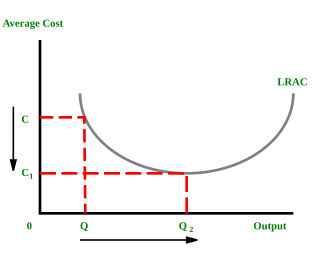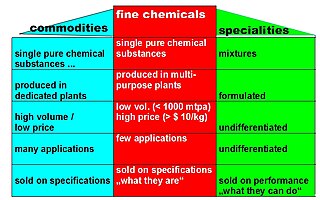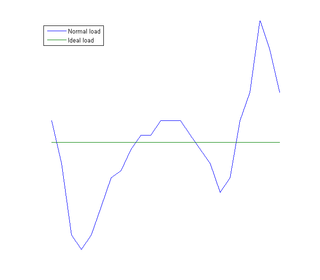
In microeconomics, economies of scale are the cost advantages that enterprises obtain due to their scale of operation, with cost per unit of output decreasing with increasing scale. At the basis of economies of scale there may be technical, statistical, organizational or related factors to the degree of market control.

Cost accounting is defined as "a systematic set of procedures for recording and reporting measurements of the cost of manufacturing goods and performing services in the aggregate and in detail. It includes methods for recognizing, classifying, allocating, aggregating and reporting such costs and comparing them with standard costs." (IMA) Often considered a subset of managerial accounting, its end goal is to advise the management on how to optimize business practices and processes based on cost efficiency and capability. Cost accounting provides the detailed cost information that management needs to control current operations and plan for the future.

A nuclear power plant is a thermal power station in which the heat source is a nuclear reactor. As is typical of thermal power stations, heat is used to generate steam that drives a steam turbine connected to a generator that produces electricity. As of 2014, the International Atomic Energy Agency reported there were 450 nuclear power reactors in operation in 31 countries.
Process engineering is the understanding and application of the fundamental principles and laws of nature that allow us to transform raw material and energy into products that are useful to society, at an industrial level. By taking advantage of the driving forces of nature such as pressure, temperature and concentration gradients, as well as the law of conservation of mass, process engineers can develop methods to synthesize and purify large quantities of desired chemical products. Process engineering focuses on the design, operation, control, optimization and intensification of chemical, physical, and biological processes. Process engineering encompasses a vast range of industries, such as agriculture, automotive, biotechnical, chemical, food, material development, mining, nuclear, petrochemical, pharmaceutical, and software development. The application of systematic computer-based methods to process engineering is "process systems engineering".

Project accounting is a specialised form of accounting that corresponds to the ever-evolving needs of project delivery, which helps adequately track, report and analyse financial results and implications. This includes the practice of creating financial reports specifically designed to track the financial progress of projects, which can then be used by managers to aid project management.
A feasibility study is an assessment of the practicality of a proposed project or system. A feasibility study aims to objectively and rationally uncover the strengths and weaknesses of an existing business or proposed venture, opportunities and threats present in the natural environment, the resources required to carry through, and ultimately the prospects for success. In its simplest terms, the two criteria to judge feasibility are cost required and value to be attained.

A chemical plant is an industrial process plant that manufactures chemicals, usually on a large scale. The general objective of a chemical plant is to create new material wealth via the chemical or biological transformation and or separation of materials. Chemical plants use specialized equipment, units, and technology in the manufacturing process. Other kinds of plants, such as polymer, pharmaceutical, food, and some beverage production facilities, power plants, oil refineries or other refineries, natural gas processing and biochemical plants, water and wastewater treatment, and pollution control equipment use many technologies that have similarities to chemical plant technology such as fluid systems and chemical reactor systems. Some would consider an oil refinery or a pharmaceutical or polymer manufacturer to be effectively a chemical plant.
Construction management (CM) is a professional service that uses specialized, project management techniques to oversee the planning, design, and construction of a project, from its beginning to its end. The purpose of CM is to control a project's time / delivery, cost and quality—sometimes referred to as a project management triangle or "triple constraints." CM is compatible with all project delivery systems, including design-bid-build, design-build, CM At-Risk and Public Private Partnerships. Professional construction managers may be reserved for lengthy, large-scale, high budget undertakings, called capital projects.
Projects and Development India Limited (PDIL) is a company under the Department of Fertilizers owned by the Government of India - it is a Mini Ratna, Category-1 and an ISO 9001:2008 Certified premier Consultancy and Engineering CPSE. PDIL started as the technology wing of Fertilizer Corporation of India in 1951, emerged as a separate entity named FPDIL in 1978 after the restructuring of Fertilizer Corporation of India and was renamed PDIL in 1981 with a head-office in Sindri, Jharkhand.
Construction accounting is a form of project accounting applied to construction projects. See also production accounting. Construction accounting is a vitally necessary form of accounting, especially when multiple contracts come into play. The construction field uses many terms not used in other forms of accounting, such as "draw" and progress billing. Construction accounting may also need to account for vehicles and equipment, which may or may not be owned by the company as a fixed asset. Construction accounting requires invoicing and vendor payment, more or less as to the amount of business done.

Fine chemicals are complex, single, pure chemical substances, produced in limited quantities in multipurpose plants by multistep batch chemical or biotechnological processes. They are described by exacting specifications, used for further processing within the chemical industry and sold for more than $10/kg. The class of fine chemicals is subdivided either on the basis of the added value, or the type of business transaction, namely standard or exclusive products.

National Fertilizers Limited (NFL) – Miniratna (Cat-1) company is an India state owned producer of chemical fertilizers, organic fertilizers and industrial chemicals. As of 2018, it was the second largest producer of fertilizers in India.
A cost estimate is the approximation of the cost of a program, project, or operation. The cost estimate is the product of the cost estimating process. The cost estimate has a single total value and may have identifiable component values.
For the application of engineering economics in the practice of civil engineering see Engineering economics.

Load management, also known as demand-side management (DSM), is the process of balancing the supply of electricity on the network with the electrical load by adjusting or controlling the load rather than the power station output. This can be achieved by direct intervention of the utility in real time, by the use of frequency sensitive relays triggering the circuit breakers, by time clocks, or by using special tariffs to influence consumer behavior. Load management allows utilities to reduce demand for electricity during peak usage times, which can, in turn, reduce costs by eliminating the need for peaking power plants. In addition, some peaking power plants can take more than an hour to bring on-line which makes load management even more critical should a plant go off-line unexpectedly for example. Load management can also help reduce harmful emissions, since peaking plants or backup generators are often dirtier and less efficient than base load power plants. New load-management technologies are constantly under development — both by private industry and public entities.
Construction bidding is the process of submitting a proposal (tender) to undertake, or manage the undertaking of a construction project. The process starts with a cost estimate from blueprints and material take offs.
In software development, effort estimation is the process of predicting the most realistic amount of effort required to develop or maintain software based on incomplete, uncertain and noisy input. Effort estimates may be used as input to project plans, iteration plans, budgets, investment analyses, pricing processes and bidding rounds.
The value of work done (VOWD) is a project management technique for measuring and estimating the project cost at a point in time. It is mainly used in project environments of the Petroleum industry and is defined as the value of goods and services progressed, regardless of whether or not they have been paid for or received. The primary purpose of determining VOWD is to get an accurate and comprehensive as possible estimate of cost for a project at a point in time. This is used in overall project management including reporting and cost control.
Chemical plant cost indexes are dimensionless numbers employed to updating capital cost required to erect a chemical plant from a past date to a later time, following changes in the value of money due to inflation and deflation. Since, at any given time, the number of chemical plants is insufficient to use in a preliminary or predesign estimate, cost indexes are handy for a series of management purposes, like long-range planning, budgeting and escalating or de-escalating contract costs.
The following is a glossary of terms relating to construction cost estimating.






